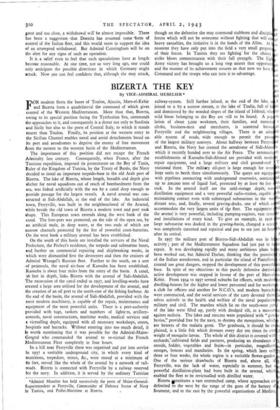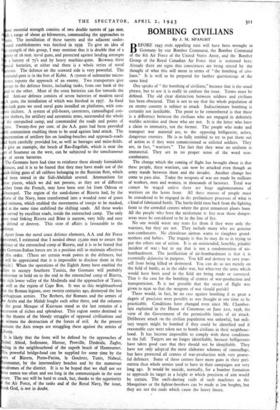BIZERTA THE KEY
By VICE-ADMIRAL MUSELIER *
FOR modern fleets the bases of Toulon, Ajaccio, Mers-el-Kebir and Bizerta form a quadrilateral the command of which gives control of the Western Mediterranean. More than that, Bizerte, owing to its special position facing the Tyrrhenian Sea, commands the approaches to it, and consequently is a threat not only to Sardinia and Sicily but also to the ports of Central Italy, to which it stands nearer than Toulon. Finally, its position at the western entry to the Sicilian Channel enables naval and aerial detachments based on Its port and aerodromes to deprive the enemy of free movement from the eastern to the western basin of the Mediterranean.
The importance of this position did not escape the French Admiralty last century. Consequently, when France, after the Tunisian expedition, imposed its protectorate on the Bey of Tunis, Ruler of the Kingdom of Tunisia, by the Treaty of Bardo, the Navy decided to instal an important torpedo-base in the old Arab port of Bizerte. The lake of Bizerta, whose length, breadth and depth give shelter for naval squadrons out of reach of bombardment from the sea, was linked artificially with the sea by a canal deep enough to provide passage for the largest vessels. A naval arsenal was con- structed at Sidi-Abdallah, at the end of the lake. An industrial town, Ferryville, was built in the neighbourhood of the Arsenal, while beside the old town of Bizerte a modern town and port took shape. This European town extends along the west bank of the canal. The fore-port was protected, on the side of the open sea, by an artificial mole, in deep water, at the two ends of which are narrow channels protected by the fire of powerful coast-batteries. On the west bank a military arsenal has been established.
On the south of this basin are installed the services of the Naval Prefecture, the Prefect's residence, the torpedo and submarine bases, and further on commercial repairing and shipbreaking works, in which were dismantled first the destroyers and then the cruisers of Admiral Wrangel's Russian fleet. Further to the south, on a sort • of peninsula, the naval air-base of Karouba has been established. Karouba is about four miles from the entry of the basin. A canal, 36 feet in depth, links Bizerta with the arsenal of Sidi-Abdallah. The excavation of the canal ended in 1937, and levelling-works have created a large area utilised for the development of the arsenal, and the creation of an oil port to the north-east of the fishing harbour. At the end of the basin, the arsenal of Sidi-Abdallah, provided with the most modern machinery, is capable of the repair, maintenance and equipment of the most powerful units. There is a port-authority provided with tugs, tankers and numbers of lighte rs, artillery- controls, naval constructions, maritime works, medical services and a victualling depot, equipped with all necessary workshops, stores, hospitals and barracks. Without entering into too much detail, it Is worth mentioning that it was possible for the Admiral-Major- Gensral who commanded the arsenal to re-victual the French Mediterranean Fleet completely in four hours.
In a hill near Ferryville there was organised and put into service In 1937 a veritable underground city, in which every kind of munitions, torpedoes, mines, &c., were stored at a minimum of 6o feet, served like the whole of the arsenal by a network of rail- roads. Bizerte is connected with Ferryville by a railway reserved for the navy. In addition, it is served by the ordinary Tunisian *Admiral Mueller has held successively the posts of Major-General- Superintendent at Ferryville, Commander of Defence Sector of Navy in Tunisia, and Prfet-Maritime at Bizerta. railway-system. Still further inland, at the end of the lake, A joined to it by a narrow.stream, is the lake of Tindja, full of fi and dominated by the wooded slopes of the island of Ishkeul, wh wild bison belonging to the Bey are still to be found. A pop lation of about 5,000 workmen, their families, and numero clerks, business-men and merchants, is scattered betw Ferryville and the neighbouring villages. There is an adm able system of roads, wide enough to permit the passa of the largest military convoys. About halfway between Ferryv. and Bizerta, the Navy has created the aerodrome of Sidi- which it recently handed over to the Air Force. The aeronauti establishments of Karouba-Sidi-Ahmed are provided with mode repair equipment, and a large military and civil ground-staff stationed there. The military oil-port is large enough for seve large units to berth there simultaneously. The quays are equipp with pipelines connecting with underground reservoirs, contai up to 200,000 tons of liquid fuel, protected by at least 6o feet rock. In the arsenal itself are the cold-storage depot, wa distillation equipment and a very powerful radio-station, capable maintaining contact even with submerged submarines in the mo distant seas, and, finally, several graving-docks, one of which accommodate the very largest units of tle fleet. The equipment the arsenal is very powerful, including pumping-engines, vast cran and installations of every kind. To give an example, in 1936 large submarine was docked in the graving-basin, changed a scre was completely Careened and repaired and put to sea just 20 hou after its arrival.
In 1937 the military port of Bizerta-Sidi-Abdallah was in fu activity ; part of the Mediterranean Squadron had just put in f repair. It was developing rapidly and many ambitious plans ha been worked out, but Admiral Darien, thinking that the proxim of the Italian aerodromes, and in particular the island of Pantelleri created too great dangers, stopped the development of this powerf base. In spite of my objections to this purely defensive decision active development was stopped in favour of the port of Mers-el Kebir. From 1934 to 1937 several suburbs for officers, with mode dwelling-houses for the higher and lower personnel and for worker a club for officers and another for N.C.O.'s, and modern barrack were constructed, and the social services of the navy devoted them selves actively to the health and welfare of the naval populatio military and civil. The marshes which lie on the south-west par of the lake were filled up, partly with dredged silt, as a measur against malaria. The lakes and streams were populated with " gam busies," provided free by the navy, to destroy the mosquitoes, which are bearers of the malaria germ_ The gembusia, it should be ex plained, is a little fish which devours every day ten times its ow weight of mosquito larvae. The whole of this district is covered with orchards; cultivated fields and pastures, producing an abundance cereals, fodder, vegetables and fruits—in particular, magnificen oranges, lemons and mandarins. In the spring, which lasts only three or four weeks, the whole region is a veritable flower-garden. One of the serious drawbacks of Bizerte and, above all, of Ferryville, was the lack of water, especially in summer, but a powerful distillation-plant had been built in the arsenal, which enabled the fleet to be revictualled with distilled water.
Bizerte *nstitutes a vast entrenched camp, whose approaches are delimited to the west by the range of the guns of the battery of Soumeur, and to the east by the powerful organisations of Metline,
es it b of
d as f4
e
J
ow essential strength consists of two double turrets of 34o mm. h a range of about 4o kilometres, commanding the approaches to
nis. The installation of these turrets and the adjacent under- ound establishments was finished in 1939. To give an idea of e strength of this group, I may mention that it is double that of a ttery of 16 mm. naval guns, and protected against landing attempts a battery of 75's and by heavy machine-guns. Between these ial batteries, at either end there is a whole series of naval aeries. The defence on the seaward side is very powerful. The mmand-post is, in the fort of Kebir. A system of submarine micro- ones 'reports the approach of an enemy. Two transporters give ssage to the defence forces, including tanks, from one bank of the nal to the other. Most of the coast batteries can fire towards the d. Anti-air defence consists of seven batteries of modern naval A. guns, the installation of which was finished in 1937. As fixed ti-tank guns we used naval guns installed on platforms, with con- ete shelters. A system of pill-boxes, casemates, camouflaged con- ete shelters, for artillery and automatic arms, surrounded the whole the entrenched camp, and commanded the roads and points of cess. Twenty-five per cent, of the A.A. guns had been provided th ammunition enabling them to be used against land attack. The ncentration of artillery fire on landing-beaches and approach-roads d been carefully provided for, as well as barrages and mine-fields.
o give an example, the beach of Ras-Engellah, which is near the t of Soumeur on the west, can be subjected to the simultaneous e of seven batteries.
The Germans have had time to reinforce these already formidable fences, and it is to be feared that they may have made use of the k-firing guns of all calibres belonging to the Russian fleet, which d been stored in the Sidi-Abdallah arsenal. Ammunition for ese pieces, which we did not possess, as they arc of different libre from the French, may have been sent for from Odessa or bastopol. The region of the sand-dunes of Bizerta had, by the orts of the Navy, been transformed into a wooded zone of pines mimosa, which enabled the movements of troops to be masked, d at the same time stabilised the shifting sands. All these works e served by excellent roads, inside the entrenched camp. The only st road linking Bizerta and Bone is narrow, very hilly and easy defend or destroy. This state of affairs is favourable to the fence.
Apart from the naval coast defence elements, A.A. and Air Force rsonnel, I estimated that I needed about 25,000 men to assure the fence of the entrenched camp of Bizerta, and it is to be feared that e German-Italian forces are in a position still to maintain effectives this order. (There are certain weak points in the defences, but will be appreciated that it is impossible to disclose them in this title.) When the operations of the Eighth Army have enabled the Ilies to occupy Southern Tunisia, the Germans will probably deavour to hold on to the end to the entrenched camp of Bizerta,
e rich lower valley of the Medjerda and the approaches. of Tunis, well as the region of Cape Bon. It was in this neighbourhood at the Roman legions, over twenty, centuries ago, destroyed the last rthaginian armies. The Berbers, the Romans and the armies of
e Arabs and the Mandi fought each other there, and the columns the great Mosque of Kairouan stand as the last remains of a ccession of riches and splendour. This region seems destined to the theatre of the bloody struggles of opposed civilisations and witness the destruction of the forces of evil. At the present oment the Axis troops are struggling there against the armies of iberty.
It is likely that the front will be defined by the approaches of jebel. Abiod, Sedjenane, Mateur, Protville, Djedeida, Zagho, ing in the neighbourhood of the superb beach of Hammamet. is powerful bridge-head can be supplied, for some time by the its of Bizerta, Porto-Farina, la Goulette, Tunis, Nabeul, mmamet, by the intermediary beaches and by the numerous odromes of the district. It is to be hoped that we shall not see ese names too often and too long in the communiqués in the near ture. The nut will be hard to crack, but, thanks to the superiority the Air Force, of the tanks and of the Royal Navy, the issue, nk God, is not in doubt.



























 Previous page
Previous page